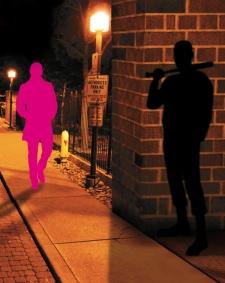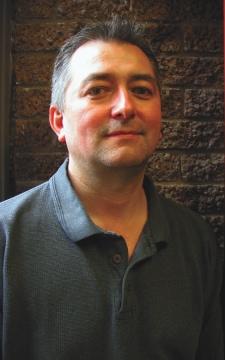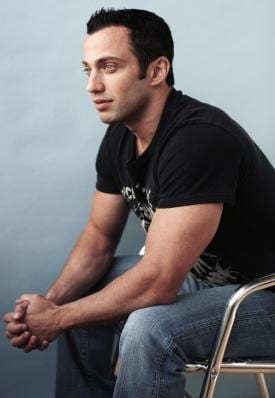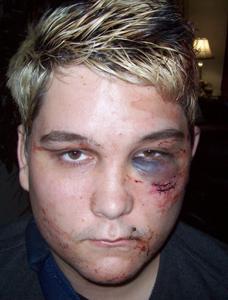
Credit: Courtesy of Brandon Wright

COUNTING GAYBASHINGS. It's hard to tell whether attacks against gay people are climbing when no standardized statistics are kept, says Doug Janoff, author of Pink Blood: Homophobic Violence in Canada. Credit: Shawn Scallen

MORE INCIDENTS, MORE REPORTING OR BOTH? In the wake of the widely reported attack against Jordan Smith, Vancouver saw a spike in reported gaybashings. Credit: David Ellingsen
In London, Ontario a gay man is attacked in the passenger seat of a truck after the driver allegedly tells him he needs to be punished for being gay.
“He started hitting me with a big, black, heavy object,” Brandon Wright told Xtra Sep 14. “He kept repeating, ‘I’m going to fucking kill you, faggot.'”
Less than two weeks later Erik Rozenski says he heard a man’s voice say, “Look those faggots are holding hands, they’re probably going to fuck tonight,” before he and his boyfriend were attacked from behind.
“My boyfriend managed to get to the middle of the road and called 911 on his cell phone,” Rozenski told Xtra Sep 29. “I fell to the ground and got kicked in the head twice.”
In Thunder Bay, another gay man is allegedly chased by a group of men shouting antigay slurs who attack him with bricks and break the left side of his face.
In the last year in Vancouver, gay men and lesbians have been punched in the jaw, pelted with eggs, hit in the face, struck with a hammer and kicked in the groin. The gaybashers allegedly yelled “I hate you,” “fucking scum,” “fuckin’ fag,” and “He’s a faggot. He deserved it.”
Since 2006 the number of hate crimes investigated by the Vancouver Police Department (VPD) has more than tripled. These numbers include hate crimes based on sexual orientation, religion, race and ethnicity.
Of the 167 incidents investigated by the VPD in the last three years, 86 were found to be hate-motivated. Twenty-six of these cases were based on sexual orientation.
Prior to 2006 the VPD didn’t track the type of hatred motivating the crime. But Insp John deHaas, inspector in command of the force’s Diversity & Aboriginal Policing Section, says the gay community is one of the most targeted groups for hate crimes.
That suggests reports of gaybashings are rising along with reports of hate crimes overall.
But deHaas acknowledges that official historical figures are nonexistent, making gaybashing trends hard to discern. “The actual level of violence over time is somewhat unknown, certainly unknown to us,” he says.
Xtra West found an increase in gaybashings in an analysis of incidents reported in its pages for more than a decade. Last year saw a significant jump — 10 cases, the most ever in one year.
From 2004 to 2008 the paper reported two to four cases a year, and the last spike was in 2002 and 2003, with eight and seven cases, respectively.
The increase mirrors a rise in reported gaybashing in some other cities.
Last year Toronto police reported 34 incidents of gaybashing, double the figure of 17 from 2007.
Seattle has had a rash of high-profile gaybashing incidents over the last few months, leading Seattle city councillor Tom Rasmussen, who is gay, to tell Seattle Gay News, “It’s been open season on gays this summer in Seattle.”
But Seattle police have recorded that malicious harassment incidents overall fell 30 percent last year and crimes that involved bias fell 17 percent, according to police figures submitted to council.
In contrast, Washington state overall has seen a 17 percent increase in hate crimes against numerous targeted groups, according to a report by the Washington State Association of Sheriffs and Police Chiefs. But hate crimes based on sexual orientation remained steady at 40 cases in 2007 and 2008.
Meanwhile reports of gaybashing seem fairly stable in other Canadian cities such as Montreal, Ottawa and Winnipeg.
Montreal hasn’t seen significant numbers of gaybashing reports since the early 1990s, says Yves Lafontaine, editor of Fugues, a gay and lesbian publication there.
Ottawa saw three gaybashings in each of 2008 and 2007, and none in 2006, according to news reports in Capital Xtra.
Sgt Monica Christian, head of Ottawa’s Hate Crimes Unit, says those numbers sound right but her team doesn’t keep statistics broken down by targeted group so she can’t say for sure.
“We don’t have the information. We’re not allowed to break it down any further,” she says, explaining that her team would be accused of profiling if it focused on black or gay men in its statistics collection.
“Do we keep them specifically — for instance assaults against black males or gay couples or gay males — no, not at all,” she says. “Actually, that’s racial profiling. That would be no.”
Though hate crimes generally number fewer than 20 per year in Ottawa, Christian says the top four groups targeted are the Jewish, black, Muslim and gay communities.
As for gaybashings specifically, Christian says nothing stands out for her in the last nine months. “But unfortunately that’s not to say it’s not happening because it’s not being reported.”
Winnipeg hasn’t seen a significant increase in reports of gaybashing either, but that’s probably because victims are unlikely to report cases since the community has a poor relationship with the police, says Chad Smith, a social worker who has studied gaybashing there.
Toronto’s police liaison to the gay community notes the inverse trend in his city.
Last year Const Thomas Decker, collaborating with several gay organizations, launched a program called Report Homophobic Violence, Period. Following the program’s introduction police reports of gaybashing rose in the second half of the year, bringing the total reports for the year to 34, double the number of incidents in 2007, he says.
But it doesn’t appear that actual incidents of gaybashing are soaring in the city.
Toronto’s 519 Anti-Violence Program saw just a 10-percent increase in reports, from 58 to 64, during the same two years. The figures are higher than the police numbers as the project keeps tabs on antigay incidents that may not be considered crimes. In the first five months of this year the program collected 24 reports of gaybashing, or the equivalent of 58 for the year, the same as in 2007.
The significant increase in police reports “is not reflective of an actual increase in violence,” Decker believes, “but it is reflective of the people’s increased level of comfort to come forward and report these incidents to police.”
Howard Shulman, coordinator of the 519’s Anti-Violence Program, agrees that the increase in reports, particularly to police, reflects an increased willingness to come forward. But he also believes that Toronto is seeing a spike in antigay incidents.
“I do believe there has been a spike that has been going on for the last few years,” he says.
Particularly as same-sex couples fan out around the Greater Toronto Area and buy homes in new neighbourhoods, Shulman says he’s heard more and more reports of antigay incidents that often start with property damage and harassment and sometimes escalate.
Whether The 519 and police statistics reflect an actual increase in incidents or a greater willingness to report them or both, the numbers are going up, Shulman notes, adding that, either way, hate crimes are still “dramatically underreported.”
“We’re starting to get a truer representation of the hate crimes that are committed against LGBT people,” he says. “I think that’s important because it raises awareness within our own community that hate crimes still happen.”
***
One of the barriers to being able to accurately count gaybashings to determine whether attacks against gay people are climbing or not is the lack of standardized statistics keeping in this area.
Doug Janoff, author of Pink Blood: Homophobic Violence in Canada, says the lack of reliable, consistent statistics is a serious problem.
It’s essential to track antigay violence in order to combat it, he says.
“Knowledge is power,” says Janoff. “How could police and community groups develop policies and programs to combat violence if they don’t really know what the numbers are? If everyone is just guessing, it makes it more difficult.”
Janoff remembers calling the RCMP when he was researching Pink Blood to ask how many gaybashings they had recorded across Canada. He couldn’t get an answer.
In the course of his research Janoff found that statistics kept on gaybashings varied significantly across Canada. Some police departments kept track of hate-motivated crimes but didn’t break the numbers down by targeted group. Others collected no statistics on hate crimes at all.
“The reality is police have so many things to keep track of all the time,” he says. If keeping hate crime statistics isn’t mandated “chances are things are going to fall through the cracks.”
Janoff would like to see legislation passed first providing a uniform definition of what constitutes a hate crime and then mandating police forces across Canada to track them. “There needs to be a consistency,” he says.
“If you can’t prove through reliable statistics that you have a problem then you don’t get the money which you need in order to develop programs to address the issue.”
Part of the difficulty, Janoff says, is that funding for such data collection is sporadic. One year a gay community centre or police hate crime unit might get sufficient funding to focus on collecting gaybashing statistics, and the next year it won’t.
So finding reliable statistics to analyze over a multi-year period is like “nailing the proverbial Jello to the wall,” he says.
“Would you say we are any closer to knowing the number of [gaybashing] cases that take place in a year? I don’t think so,” he says, once again calling for a “real attempt to create a more uniform approach to record keeping.”
“We can only act on things if we’re clear about how widespread and prevalent a social phenomena is,” he says. Even if gaybashings are “taking place before our very eyes, unless we have numbers we cannot with any certainty” get the resources and funding required to address the problem.
***
Back in Vancouver, Jordan Smith was determined to see the assault against him reported — and recorded — as a hate crime.
“I didn’t want this to just fall down as some common assault because I thought it was more than that,” he says. “I think it was a targeted type of hate-motivated crime.”
One moment, Smith was walking down Davie St holding hands with Charles McKay, now his boyfriend. The next moment, they allegedly heard someone yell “faggot” and “queer” and “What the fuck is this?”
Smith had to be taken away in an ambulance and his jaw wired shut to heal. The WestJet pilot not only filed a police report but also alerted journalists he knew, he says. His case goes to trial in April 2010.
“I personally think a lot of stuff happens in the gay community that’s unreported” in the media, Smith says. “And I think the only way that there will be a change is if incidents are reported. If people don’t hear about it then things aren’t going to change.”
Jack Herman, cofounder of Vancouver’s West Enders Against Violence Everywhere (WEAVE), attributes the rise in reports of gaybashing to courageous younger people and better police outreach.
“Younger gay men are more willing to report because they’re not as afraid as the older generation, and that’s hand in glove with the Vancouver Police treating them with dignity and taking them seriously,” he says.
But gay MLA Spencer Herbert, who represents Vancouver’s largely gay West End, says, “The bigger question we’ve got to ask is. ‘Why aren’t we safe interacting on the street?'”
The answer, he says, lies in “people’s fear or hatred of difference.”
“As a community, we have to be bold again,” Herbert says. “We should have the right to be free to hold hands and kiss our lovers in every corner of this province.”
Herman suggests the increasing profile of the gay community could be provoking a backlash, especially as gays and lesbians dare to express more affection in public.
“I’m declaring I’m not ashamed of whom I’m in love with, but at the same time it can prompt a yahoo to start an altercation,” he says. “I think it’s a very powerful and prideful thing to do. But I think that it has its consequences when somebody doesn’t like that fact.”
“I would never say don’t hold hands in public,” Herman adds. “But I would say you’d better be real sure of your surroundings.”
When black people in the United States started demanding equal rights and equal access to their political system and schools “there was obviously a backlash of violence against the black community of America,” Herman notes.
If people are “prone to violence and they’re homophobic, I think that makes them angry that there’s a bigger profile for queer guys,” he says.
Some bashers may think the government has gone too far in granting rights to gays and lesbians, Shulman agrees. Bashers could be behaving as vigilantes, trying to enforce old-fashioned norms.
“A lot of time it’s just fear of difference,” he says, echoing Herbert.
“It starts really early,” Shulman notes. People hear “fag” and “that’s so gay” in school. Often they don’t even know what the words mean but they know they’re bad and that they should distance themselves from the individual being targeted.
That’s why education should be “more holistic,” Shulman says. Kids should learn early on about gay people’s contributions to Canadian history and literature and the like, and that gay sex was illegal in Canada prior to 1969, he suggests.
Herbert agrees. Provincial governments should work with school boards to ensure all schools are providing antihomophobia education, he says.
The gay community needs to work with all levels of society, from governments to community groups to families, to “promote a culture of acceptance and celebration of diversity,” Herbert says.
“We should never cower from bullies,” he adds, urging more and more people to come out. “It’s so much easier to hate the ‘other’ when you don’t know who they are. Visibility, I think, is very important.”
Some people also have a tendency to blame those they perceive to be outsiders in times of economic struggle, Herbert
notes. “Right now in this time of economic trouble that could happen.”
The economic downturn is another factor that could explain the apparent rise in gaybashings, agrees WEAVE’s Velvet Steele.
“People need an outlet,” she says. “A lot of people who are losing these jobs who are being displaced get all upset and get all pissed off and say, ‘Oh, there’s a fag. Let’s go beat the shit out of them’ because they need to vent their frustrations.”
There has also been a lot more mixing in gay clubs, with many straight people going to traditionally gay spaces. While many hail that as a move toward a more accepting society, there have been some incidents.
A Winnipeg bar called Club Desire billed itself as straight-friendly, says Smith, the Winnipeg-based social worker. But some patrons of the club have been pushed and called a “faggot,” he says.
“People have talked about being there and going up to someone and striking up a conversation and having things said like ‘I’m not fuckin’ gay,'” he says.
Shulman says a straight man assaulted a gay man he said had come onto him at a Toronto bar last year.
And Ritchie Dowrey was allegedly gaybashed at The Fountainhead Pub in Vancouver in March by a straight man who allegedly told witnesses that Dowrey is a “faggot” and deserved it.
Others see mixing in gay bars as progress.
“I would like to think that people who come into bars where the majority of clientele are gay are really our friends,” says Jim Deva, co-owner of Little Sister’s bookstore, “and it’s nice that we’re making more friends. It’s that interaction between communities that creates progress.”
Still others point to the proximity of Vancouver’s gay village to its straight club district as part of the problem. There have been reports of people getting drunk on Granville St then making their way just a few blocks over to Davie St to bash someone in the gay village.
“Alcohol nearby seems to add to the problem,” deHaas acknowledges.
Herbert says he has heard of reports of gaybashings throughout British Columbia, including Kamloops, Prince George and Logan Lake. But he, too, says it’s difficult to determine whether there is an increase in reporting or actual incidents.
If the rise merely reflects increased reporting, it’s a good thing, he says.
But, he adds, “either way we’ve got a lot of work to do.”
– With files from Robin Perelle and Natasha Barsotti

 Why you can trust Xtra
Why you can trust Xtra


